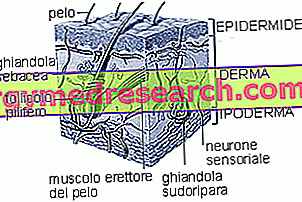The skin is formed by an epithelium (epithelial cells) called epidermis, from a connective tissue (elastic cells and collagen) called dermis and from a fatty tissue that takes the name of subcutaneous .
In the dermis and in the subcutaneous are contained the cutaneous appendages (nails, hairs and hair), the vessels and the nerves .

The basal layer is adjacent to the dermis and consists of a single layer of cylindrical keratinocytes. They represent the germinative cells of the epidermis, on whose division depends the continuous renewal of the epithelium. Between the basal keratinocytes there are melanocytes, cells whose main function is to produce and secrete melanin and then transfer it to keratinocytes. They are more numerous in photo-exposed areas such as the face and less in the trunk.

Above the spiny cells, as they mature and begin to keratinize, we find the granular layer, which usually has a thickness of 1 or 2 cells.
The shiny layer is located above the grainy but it is clearly evident only in some locations, especially the palms of the hands and the soles of the feet.
The superficial layer of the epidermis is the stratum corneum, usually of a thickness equivalent to 3-4 cells. In it, the cells are composed mainly of keratin filaments and aggregate giving it a "woven basket" appearance. In areas subjected to pressure or trauma it is thickened and thickened.
The dermis is composed of two parts, the papillary, located below the epidermis, and the reticular, located between papillary and hypodermis. It contains collagen (which allows it considerable tensile strength), elastic fibers (which give it a reversible extensibility), glycosaminoglycans (which give it hydration and turgor) and skin appendages, ie the hair follicles and the structures associated with it (sebaceous glands and erector muscles of the hair).



